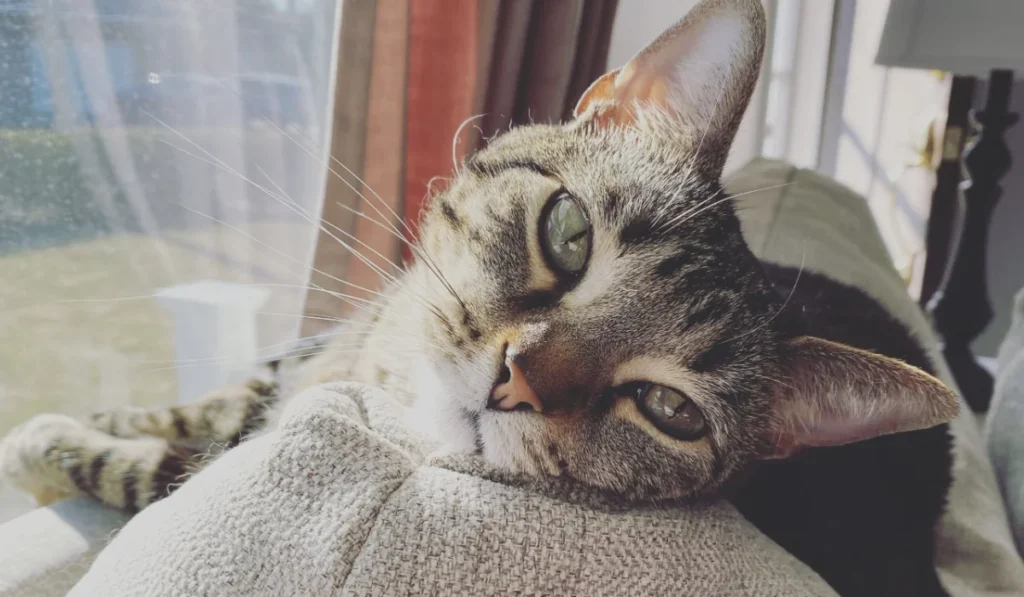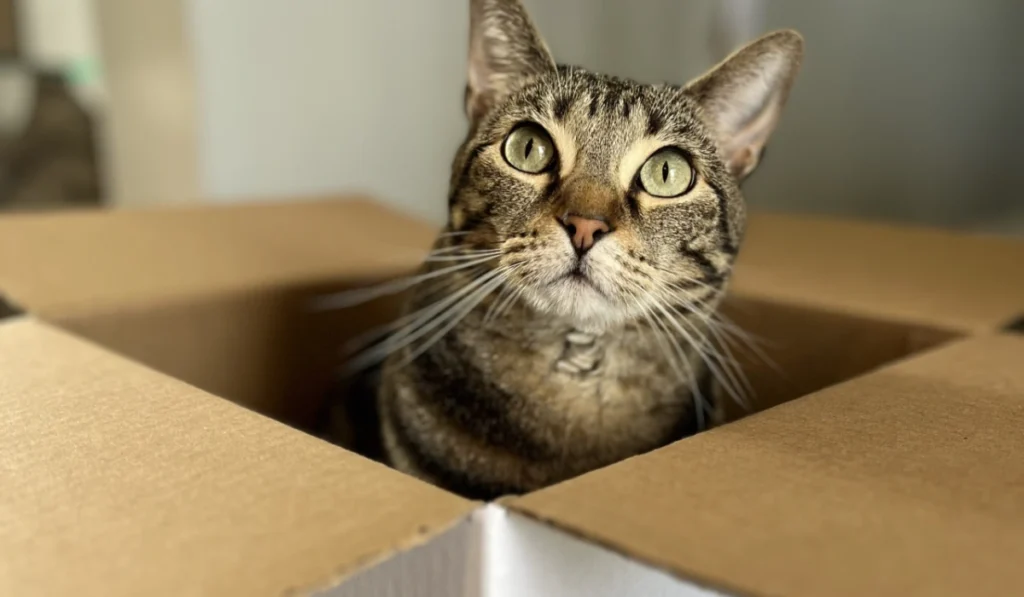
Did you know that between 50 and 90% of cats older than four years suffer from some form of dental disease? Yeah, me neither. Let’s be honest; most of us aren’t spending too much time worrying about our cats’ dental health. I mean, cats in the wild do just fine without regular dental care, right?
Sadly, this is a big misconception. Left untreated, dental disease can lead to a decreased quality of life for our fur babies, causing a great deal of pain and discomfort. Cats can even stop eating in severe cases, which comes with its own set of health issues. Keep reading to learn more about how dental health contributes to overall health of our cats, symptoms of dental disease to look out for, and when to see a veterinarian.
Note: I am not a medical professional, and this article is not to be taken as medical or veterinary advice. Always contact a veterinarian regarding your pet’s health. Additionally, Caitycat is a participant in the Amazon Services LLC Associates Program, an affiliate advertising program designed to provide a means for sites to earn advertising fees by advertising and linking to amazon.com. As an Amazon Associate, I earn from qualifying purchases. This post may contain affiliate links, which means I may receive a commission, at no extra cost to you, if you make a purchase through a link. Please see my full disclosure for further information.
Subscribe to my newsletter for all things cats!
Pin it for later!
Common Dental Problems in Cats and Kittens
Cats of any age can develop dental health issues, and kittens are no exception. Kittens have what are called milk or deciduous teeth that begin to break through when they are approximately 3 or 4 weeks old, though this can vary slightly between breeds. These deciduous teeth then start to fall out by the time a kitten reaches 3 or 4 months old, with all their adult teeth making their appearance by the time they are about 6 months old. When kittens are actively going through the teething process, they can develop gingivitis or periodontal disease, which presents as swollen and/or bleeding gums, as well as halitosis (bad breath). I can attest to the bad breath, as my 8-month-old kitten Hazel is still actively teething… yikes! Many times this will resolve once the kitten has finished teething, but it can persist into adulthood.
Some of the most common dental health issues seen in adult cats are:
- Tartar/Plaque Buildup
- Plaque occurs when bacteria from saliva and food particles collect on the teeth, and if untreated for too long it can harden to create tartar. This irritates the cat’s gums and can lead to dental disease.
- Gingivitis
- Gingivitis presents as inflammation of the cat’s gums that develops due to the presence of excess plaque. The bacteria present in the plaque begin to travel deeper toward the gumline, leading to red, painful, and swollen gums. Ouch!
- Periodontitis
- This is essentially a more severe form of gingivitis that not only impacts the gums, but the periodontal ligaments and jawbone as well. Periodontitis can lead to loose teeth, pain, and even permanent tooth loss. It often requires antibiotics and a professional cleaning at the vet.
- Tooth Resorption
- Tooth resorption occurs in cats due to resorptive lesions, which are suspected to form due to inflammation caused by periodontitis. This causes the structure of a tooth to break down from the inside out. Often the affected teeth need to be surgically removed.
- Stomatitis
- Stomatitis is a chronic condition that includes inflammation of the gums that extends to other parts of the mouth’s lining. It typically starts as gingivitis.
Recognizing the Symptoms of Dental Problems in Cats
There are some key signs and symptoms you should be on the lookout for in your fluffy feline friends that can point to poor dental health. Some of these signs include:
- Excessive drooling
- Bad breath (Halitosis)
- Swollen, red, or bleeding gums
- Difficulty eating and/or reduced appetite
- Pawing at the mouth
- Loose teeth
- Behavioral changes
If you notice any of these symptoms in your cat, it’s best to give your veterinarian a call to make sure any serious dental health issues are ruled out.

The Link Between Dental Health and Overall Health
Sadly, poor dental health can occasionally lead to more serious issues and can ultimately contribute to a lower quality of life for our kitties. For instance, bacteria present in the mouth due to gingivitis can eventually enter the bloodstream and affect key organs such as the kidneys, liver, or the heart. Additionally, if your kitty has severe pain in their mouth due to dental disease, they may have a reduced appetite or even stop eating altogether; and when cats stop eating, this can lead to a multitude of additional issues including dehydration, immune system failure, depression, and hepatic lipidosis.
How to Prevent Dental Issues in Cats
Fortunately, dental disease can be prevented by taking proactive measures, especially if these measures are taken when your kitty is still young. Regular brushing using cat-specific toothbrushes (like this one with a micro head: https://amzn.to/3PIQ3Gy) and enzymatic pet toothpastes (such as this one: https://amzn.to/3CjOsnt) can be very helpful in preventing dental health issues, particularly if done on a routine basis. Starting this practice when you first bring your furry friend home is recommended, as not many cats enjoy having their teeth brushed. There are also dental wipes, water additives, and dental treats that can be helpful in keeping dental issues at bay.
Hydration also plays a key role in maintaining your cat’s dental health. When a cat is dehydrated, their saliva production is reduced. This leads to an array of issues in the mouth, as saliva plays a key role in cleaning teeth, neutralizing acids, and keeping the buildup of plaque on the teeth at a minimum. You can ensure your cat stays hydrated by offering wet food as part of their diet, or providing a water fountain as some cats prefer to drink out of a moving water source.
Treatment for Dental Disease
If your cat is showing signs of dental disease, it’s best to contact your veterinarian so they can provide a full examination and determine the necessary treatment for your cat’s particular case. The treatment will vary depending on the severity of the issue. Some treatments may include:
- Professional dental cleaning (performed under anesthesia)
- Tooth extractions
- Scaling and/or polishing
- Pain medications
- Antibiotics
In Conclusion…
It is vitally important to take steps to prevent dental issues in your kitty, as dental health that is neglected for long periods of time can lead to a host of serious health issues. Regular brushing, veterinary check-ups, and proper hydration can go a long way in maintaining a healthy mouth, and in turn a healthy, happy kitty.

Additional Resources
This cat toothbrush (linked here: https://amzn.to/4h084fk) with a micro head is specially designed for easily reaching and cleaning the inner surfaces of cats’ gums. I use this toothbrush for my two fur babies and I’ve never had such an easy time brushing my cats’ teeth!
This enzymatic pet toothpaste (linked here: https://amzn.to/4anB7Hf) is vet-recommended and my cats LOVE the poultry flavor! I used to have such a hard time brushing my babies’ teeth since the flavors of pet toothpastes are usually very off-putting. Not this one…they think it’s a treat!
Watch this how-to video for a tutorial on how to properly clean your cat’s teeth.
Follow this account on Instagram for daily advice and information on cat dental health!
Did you find this article helpful? Let me know in the comments!
- Decorating With Cats: Tips for a Cat-Friendly Holiday Season
- Cat-Proof Fish Tanks: How to Keep Cats and Aquariums in the Same Home
- Home Remedies for Cat Anxiety: How to Calm an Anxious Cat
- Do Cats Know When You Are Sad? Signs Your Cat Feels Your Emotions
- Best HEPA Air Purifier for Cat Allergies: Jafända Air Purifier Review
